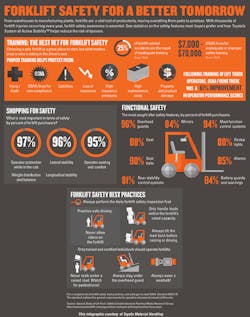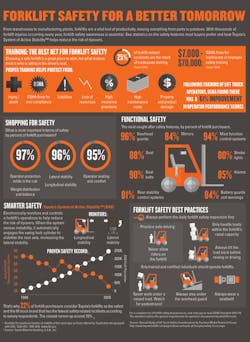Forklift Safety: Tips on Operator and Employee Training [Infographic]
Powered industrial trucks can either be ridden by the operator or controlled by a walking operator. There are many types of powered industrial trucks. Each type presents different operating hazards. For example, a sit-down, counterbalanced high-lift rider truck is more likely than a motorized hand truck to be involved in a falling load accident because the sit-down rider truck can lift a load much higher than a hand truck.
Workplace type and conditions are also factors in hazards commonly associated with powered industrial trucks. For example, retail establishments often face greater challenges than other worksites in maintaining pedestrian safety. Beyond that, many workers can also be injured when:
- Lift trucks are inadvertently driven off loading docks;
- Lifts fall between docks and an unsecured trailer;
- They are struck by a lift truck; or
- They fall while on elevated pallets and tines.
Determining the best way to protect workers from injury largely depends on the type of truck operated and the worksite where it is being used. Employers must ensure that each powered industrial truck operator is competent to operate a powered industrial truck safely, as demonstrated by the successful completion of the training and evaluation specified in 29 CFR 1910.178(l)(1).
This infographic, Forklift Safety for a Better Tomorrow, highlights safety tips and offers advice about the importance of operator and employee training.
No job can—or should—be completed without proper safety protocols in place. This is particularly true when dealing with heavy machinery, such as forklifts, in the workplace. Learn the key features of a safe forklift, the statistics on the features that most buyers prefer, and the best practices for workplace safety while operating a forklift.
For more information visit, www.toyotaforklift.com.
About the Author

Sandy Smith
Sandy Smith is the former content director of EHS Today, and is currently the EHSQ content & community lead at Intelex Technologies Inc. She has written about occupational safety and health and environmental issues since 1990.

